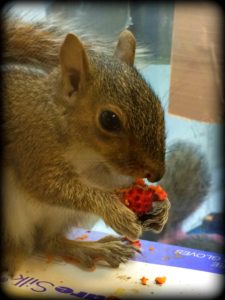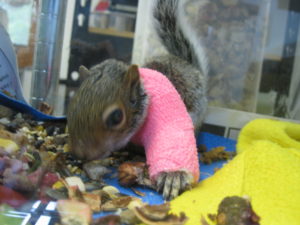
Want to be a volunteer forager, but don’t know who to donate your gift to? As I addressed elsewhere, wildlife rehabilitation is an activity regulated by state laws, so whether or not wildlife rehabilitation exists in your state and how it is organized is something you will need to explore.
How to Cold Call a Wildlife Rehabber to Discuss Wild Food Collecting
- In Virginia, you can find rehabilitators through the Virginia Department of Game and Inland Fisheries. VDGIF is the regulating and enforcing body in Virginia for wildlife rehabilitation. You’ll see that some rehabilitators work with many or all species of wildlife. Some specialize in just one or two species.For other states, I recommend starting with a Google search. You can also get some limited help from the National Wildlife Rehabilitators Association . Or you can try your state’s game and hunting management department.
- Use this website to do a little research into what wild foods are eaten by the animals you are considering foraging for. Look for foods that you have easy access to in your yard or neighborhood. Come up with some different possibilities of which animals you might be best situated to serve, based on what plants you have+ what plants you know + distance from the rehabber.
- Now that you have thought through in some detail what you have to offer, it is time to call the rehabber to pitch your idea. Rehabbers are VERY busy at certain times of the year…March- August. If you can, try to make your first contact with the rehabber between September and March.
- Prepare a little “elevator pitch” so you can leave a message on their answering machine if you do not get them. Here’s what I would say:
Hi! I am calling for ____, the wildlife rehabilitator. My name is ____, and I am a (gardener/native plant enthusiast/plant forager). I am interested in speaking to you about the possibility of my volunteering to help supply foraged wild foods for your wildlife patients. My interest is making it easier for you to use wild plant foods in your practice. Please call or email me if you are interested in discussing this possibility further.
- Let’s say you talk and get to the point where you decide to work together.
- Make sure to learn and discuss the following:
- Are there particular species of animals the rehabber wants wild foods for more than other species?
- What species of animal(s) will you be collecting food for?
- Approximately how many animals does the rehabber have at any given time, and totally per year?
- What ages are the animals the rehabber serves?
- Are there wild foods or types of foods (greens, fruits, nuts) the rehabber specifically would like help with?
- How will the rehabber communicate to you how many weaned animals they have at any given time, since the numbers of animals in rehab fluctuates a lot from day to day, week to week?
- What is the rehabber’s preferred method of communicating? (Phone, text, email?)
- Is there a preferred day or time of day for you to deliver the food?
- What is the length of time the rehabber can expect help from you…all season (and get the rehabber to define what that is) or a more limited agreement…like all acorn and hickory season?
- Are there storage limitations…like limited refrigerator space?
Then, when you start to collect food, follow ethical foraging guidelines.
- The best practice is to get your foods to the rehabber as fresh as possible. Fruits and greens should be refrigerated until transported. Cut browse should be stored in a bucket of water and kept in as cool of a spot as possible.
- Foods should be packaged separately and labelled clearly with
- Date harvested
- Name of the plant
- Who eats it (if the rehabber works with more than one species of animal)
- Keep some records so you can learn as you go. And you may find that you now look at all plants with the eye of “What is that and who can eat it?” Learn at your own place and at your own pace!
Just remember:
- Rehabbers are usually volunteers like yourself.
- Rehabbers are extraordinarily busy people, especially in spring and summer when they have the most wild mouths to feed, so it is important for you to do what the rehabber actually wants, rather than what you think would help.
- Even once you start delivering food, take some time in the off-season to get some feedback about what worked and what did not from the rehabbers perspective. Remember, you are spending your valuable time doing this time-consuming foraging. So you want figure out how to make it easy for the rehabilitator to get all that wild food into wild mouths!
- And one last word. Don’t assume the rehabilitator knows who to feed your precious gifts to. Take the time to print out a list of animals that eat the food you are supplying. Anything you can do to make it quick and easy on the rehabber increases the chances your efforts will be utilized fully. It is hard for non-rehabbers to imagine just how busy rehabbers are in the baby season.

